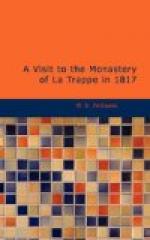The refectory was furnished with long wooden tables and benches; each person was provided with a trencher, a jug of water, and a cup, having on it the name of the brother to whom it is appropriated, as Frere Paul, Frere Francois, &c. which name they assume on taking the vow. Their supper consisted of bread soaked in water, a little salt, and two raw carrots, placed by each; water alone is their beverage. The dinner is varied with a little cabbage or other vegetables: they very rarely have cheese, and never meat, fish, or eggs. The bread is of the coarsest kind possible.
Their bed is a small truckle, boarded, with a single covering, generally a blanket, no mattress nor pillow; and, as in the former time, no fire is allowed but one in the great hall, which they never approach.
Within these three years a small cabaret has been built near the Convent for the accommodation of those who may occasionally visit it, the buildings that remain being but barely sufficient for their own members, which have been rapidly increasing since its restoration. In this cabaret I took up my abode for the night, in preference to the accommodation very kindly offered me by Frere Charle, and retired to rest, wearied with the day’s excursion, and fully satisfied, that all I had heard, all I had imagined of La Trappe, was infinitely short of the reality, and that no adequate description could be given of its awful and dreary solitude;
Monsieur Elzear de Sabran, in a poem called Le Repentir, lately published, describing this Monastery, says very justly;




